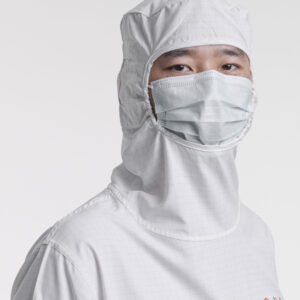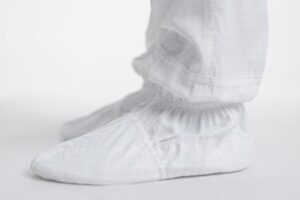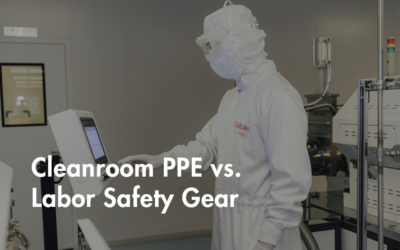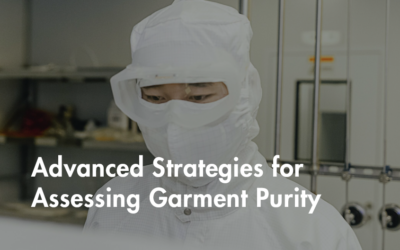A Comprehensive Guide for cleanroom garments
Cleanroom garments are specialized clothing worn in cleanroom environments to minimize contamination. They are designed to protect both the wearer and the environment from particles, dust, and other contaminants. Cleanroom garments typically include coveralls, hoods, boots, and gloves, and are made from materials that are non-shedding and easy to clean. The level of cleanliness required dictates the type of garments used, with higher cleanliness levels requiring more stringent garment standards.

Typical cleanoom garments are divided into disposable and reusable garments.
Disposable cleanroom garments are designed for single-use applications and are typically made from materials like polypropylene or other non-woven fabrics. Once used, disposable garments are discarded.
Reusable cleanroom garments, on the other hand, are designed to withstand multiple uses and are made from more durable materials such as polyester or synthetic blends. They are laundered and sterilized between uses to maintain their effectiveness and cleanliness. Reusable garments are more environmentally friendly and cost-effective than disposable ones.
Prolonging the service life of reusable cleanroom garments is essential to ensure their effectiveness and to minimize costs associated with replacement. Proper care and maintenance practices can significantly extend the lifespan of these garments. In this article, we will discuss various strategies and best practices to help you maximize the service life of your cleanroom garments.
Importance of Prolonging Service Life of Cleanroom Garments
Prolonging the service life of cleanroom garments is crucial for several reasons:
- Cost-Effectiveness: Extending the lifespan of cleanroom garments can lead to significant cost savings over time. By reducing the frequency of replacements, organizations can lower their overall expenditure on protective clothing.
- Environmental Impact: Disposable cleanroom garments contribute to waste generation. Prolonging the service life of reusable garments helps reduce the amount of waste produced, promoting environmental sustainability.
- Consistency in Performance: Well-maintained cleanroom garments provide consistent performance in terms of protecting both the wearer and the cleanroom environment from contaminants. This consistency is crucial for maintaining product quality and meeting regulatory standards.
- Regulatory Compliance: Many industries, such as pharmaceuticals and electronics, have strict regulations regarding cleanroom practices and garment standards. Prolonging the service life of cleanroom garments helps ensure compliance with these regulations.
- Employee Safety and Comfort: Properly maintained cleanroom garments enhance employee safety and comfort. Garments that are in good condition provide better protection against contaminants and are more comfortable to wear.
- Enhanced Productivity: When employees are equipped with high-quality cleanroom garments that are in good condition, they can work more efficiently and effectively, leading to improved productivity.
- Image and Reputation: Maintaining cleanroom garments properly reflects positively on an organization’s image and reputation. It demonstrates a commitment to quality, safety, and environmental responsibility.
Strategies for Prolonging Service Life of Cleanroom Garments
- Regular Inspection: Ensuring the optimal performance and longevity of cleanroom garments requires a commitment to conducting thorough and frequent inspections both before and after each use. These examinations should be approached with meticulous attention to detail, carefully scrutinizing the garments for any signs of wear, damage, or contamination. Specifically, inspectors should be vigilant for indications such as tears, punctures, holes, fraying, or loose seams, as these can compromise the integrity of the garments and their ability to maintain the required level of cleanliness and protection.
During these meticulous inspections, it is essential to utilize appropriate lighting and magnification to detect even the smallest imperfections that may be present. Additionally, inspectors should be trained to recognize the various types of damage that can occur and understand the implications of each in terms of garment performance and safety.
Upon identifying any issues, whether minor or significant, it is imperative to take immediate action to address them. This may involve repairing the garment using suitable methods and materials or replacing it entirely if the damage is severe. Prompt and effective remediation is essential to prevent further deterioration and maintain the overall effectiveness of the garments in preserving the cleanliness of the environment and ensuring the safety and well-being of personnel working within it.
- Proper Storage: To ensure the longevity and effectiveness of cleanroom garments, it is essential to adhere to strict storage practices. Garments should be stored in a designated area that is clean, dry, and free from environmental contaminants. Avoid exposing the garments to direct sunlight, as prolonged exposure can lead to fabric degradation and loss of protective properties. Similarly, moisture should be kept at bay, as damp conditions can promote the growth of mold and mildew, compromising the integrity of the garments.
Furthermore, it is crucial to protect cleanroom garments from contact with harsh chemicals, as exposure can cause damage to the fabric and diminish their effectiveness in providing a barrier against contaminants. When storing garments, ensure they are not in close proximity to any substances that may pose a risk of contamination.
Proper storage also includes utilizing appropriate storage solutions, such as garment racks or cabinets, to prevent garments from coming into contact with the floor or other surfaces. Hanging garments on hangers designed for cleanroom use can help maintain their shape and prevent wrinkles, ensuring they are ready for use when needed.
- Correct Laundering: To ensure the longevity and effectiveness of cleanroom garments, it is imperative to adhere to proper laundering practices. Begin by carefully following the manufacturer’s laundering instructions, as outlined on the garment’s label. Use mild detergents and wash at the recommended temperature to avoid damaging the fabric. It is essential to avoid using bleach or harsh chemicals, as they can weaken the fabric fibers and compromise the integrity of the garment.
Cleaning: Before initiating the cleaning process, conduct a meticulous inspection of the garments for any damages, stains, or missing accessories. Any defective garments should undergo repair, replacement, or be discarded to maintain the overall effectiveness of the cleanroom attire. Stained garments require pre-treatment for stain removal before washing to ensure optimal cleanliness.
Ensure that garments designated for different uses and areas are washed separately to prevent mutual influence and cross-contamination. Utilize a special detergent with non-ionic surfactants and a neutral pH value to guarantee garment performance and longevity.
During the cleaning process, opt for sand core filtered water and pure water to maintain the cleanliness and integrity of the garments. Dust-free purification workshops must employ ultrapure water, not ordinary industrial water, to ensure the garments are properly cleaned. The final rinse should be executed with filtered pure water to remove any remaining contaminants and detergent residue, ensuring the garments are thoroughly clean and ready for use in the cleanroom environment.
View Gaible’s cleaning of cleanroom suits at Gaible – cleaning of cleanroom suit (youtube.com)
- Gentle Handling: It is of utmost importance to handle cleanroom garments with the utmost care and delicacy to prevent unnecessary wear and tear. Avoid dragging them on the floor or exposing them to sharp objects that can potentially cause damage, compromising their effectiveness and lifespan. By handling them gently, you can ensure that they maintain their integrity and continue to provide the necessary protection.
Proper Donning and Doffing: Following the correct procedures for donning (putting on) and doffing (taking off) cleanroom garments is essential to avoid stretching or tearing the fabric. When donning the garments, take care to do so in a controlled manner, avoiding any sudden movements that could cause damage. Similarly, when doffing the garments, take your time and follow the recommended steps to prevent any mishaps that could lead to damage.
It is also important to use caution when using gloves or other protective gear in conjunction with cleanroom garments. Ensure that the gloves are compatible with the garments and do not pose a risk of causing damage.
View Gaible’s gowning procedure for 3-in-1 coverall iGaible cleanroom suit|Upgraded 3-in-1 Cleanroom Coverall Gowning Procedure (youtube.com)
- Regular Maintenance: It is highly advisable to establish a schedule for regular maintenance checks for cleanroom garments to ensure they remain in optimal condition. These checks should include a thorough inspection of the garments to identify any signs of wear or damage. It is essential to promptly replace any worn-out components such as zippers, buttons, or elastic bands to maintain the integrity and effectiveness of the garments in providing the necessary protection.
- Training and Education: Providing comprehensive training to personnel on the proper care and maintenance of cleanroom garments is crucial. Personnel should be educated on the importance of following guidelines and best practices to maximize the lifespan of these garments. This training should cover proper handling, storage, laundering, and inspection procedures to ensure that cleanroom garments are maintained in good condition and continue to provide the required level of protection.
View Gaible’s folding process for 3-in-1 coverall Gaible cleanroom suit|Upgraded 3-in-1 cleanroom coverall Folding process (youtube.com)

7.Proper Use: It is paramount to adhere strictly to guidelines regarding the use of cleanroom garments, ensuring they are utilized solely for their intended purpose and within the appropriate cleanroom environment. Avoid exposing the garments to any contaminants or conditions that may compromise their effectiveness, such as chemicals, liquids, or extreme temperatures. By using the garments correctly and in accordance with their intended purpose, you can help maintain their integrity and ensure they continue to provide the required level of protection.
Prolonging the service life of cleanroom garments is essential for cost savings, environmental sustainability, regulatory compliance, employee safety and comfort, productivity, and maintaining a positive image and reputation. Implementing proper care and maintenance practices is key to achieving these benefits.
Prolonging the service life of cleanroom garments is paramount, as it contributes to various critical aspects of operational efficiency and effectiveness. By extending the lifespan of these garments, organizations can achieve significant cost savings over time, reducing the frequency of replacements and minimizing their overall expenditure on protective clothing. Additionally, prioritizing the longevity of cleanroom garments promotes environmental sustainability by reducing the amount of waste generated by disposable garments. Besides, it is essential for ensuring regulatory compliance in industries where adherence to strict cleanliness and safety standards is mandatory and organizations can enhance employee safety and comfort. Well-maintained garments provide consistent protection against contaminants, ensuring the safety and well-being of personnel working in cleanroom environments.
To achieve these benefits, it is crucial to implement proper care and maintenance practices for cleanroom garments. This includes conducting regular inspections, proper storage, correct laundering techniques, gentle handling, and ensuring proper use of the garments. By following these practices, organizations can prolong the service life of cleanroom garments and reap the associated benefits.






0 Comments